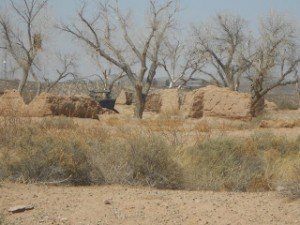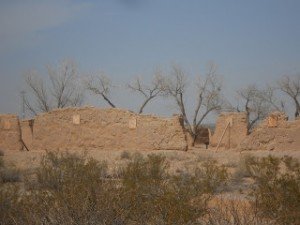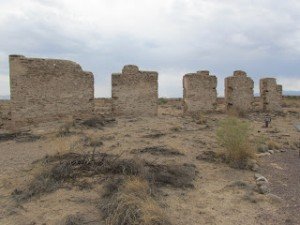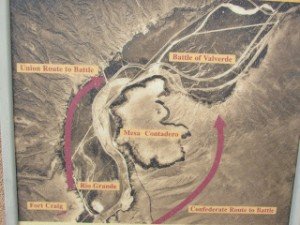Thank you for reading this post, don't forget to subscribe!
The state of New Mexico is home to a great many historic sites. The rich history of New Mexico includes the Native Pueblo peoples of the southwest, it’s occupation by the Spaniards followed by the Mexicans and beginning in 1846 the occupation by the United States. This mixture of cultures is why New Mexico is such a fascinating state to visit.

Old Military Forts
When New Mexico was made a territory of the U.S., military outposts were established along the Rio Grande. The Rio Grande generally followed the main travel route between the capital of Santa Fe and Mexico. This was the El Camino Real, the trail carved out by the Spanish Conquistadors. It was the lifeline for supplies between Mexico City and Nuevo Mexico.
It was only natural for military forts to be established along this route. The forts and their garrisons would be key to the U.S. settlement of the territory including protection against Indian raids.
Two Historic Western Forts and Their Ruins
Traveling south to north from Las Cruces along Interstate-25 will take you past two old U.S. Army forts which today lay in ruins. While today the fort’s are in ruins we’re fortunate that the sites have been preserved so that they can be explored by future generations.

Fort Selden
The ruins of Fort Selden, located about thirteen miles north of Las Cruces New Mexico and just west of Interstate 25 near the Rio Grande, is today a New Mexico State Monument. Visiting historic Fort Selden, viewing the ruins and exploring through the Visitors Center, will paint a good picture of what life was like for the soldiers stationed at this frontier fort.
Buffalo Soldiers comprising eight companies of the 125th Infantry were sent to New Mexico Territory. These troops were the first stationed at Fort Selden and would eventually serve at seven forts throughout the territory. At Fort Selden, these Buffalo Soldiers along with others would go on to construct the buildings including the army hospital. Buffalo Soldiers of the 9th Cavalry stationed at Fort Selden played a major role in chasing down the Apache leader Victorio who was leading many of the deadly raids in southern New Mexico.
Fort Selden, located just west of Interstate-25 is very easy to reach from the Interstate and makes an excellent addition to your New Mexico road trip planner. The state monument is open Wednesday through Monday. The site is closed on Tuesday. Take Exit 19 off of Interstate-25 about thirteen miles north of Las Cruces. The fort is located in the town of Radium Springs, NM.

Fort Craig
Fort Craig is a National Historic Site which was taken over by the BLM in 1981. The site consists of a Visitors Center and the ruins of the once large and proud military fort. Fort Craig was named for U.S. Army Captain Louis S. Craig who was murdered by deserters in California in 1852.
Fort Craig was built in 1854 and was considered one of the largest and most important frontier forts in the West. Fort Craig played a big role in both the New Mexico Indian campaigns as well as in the American Civil War. Fort Craig was home to the Buffalo Soldiers of the 9th Cavalry and 38th and 125th Infantry.

Fort Craig lies adjacent to the site of what many believe was the largest Civil War battle in the southwest. This was the Battle of Valverde fought on February 21, 1862. The batttle lasted the entire day. While the Confederates (mostly Texans) prevailed in this battle, and were thus able to thrust further north to Albuquerque and Santa Fe, they were later defeated at the Battle of Glorieta Pass just to the east of Santa Fe. The site of the Battle of Valverde is just to the northeast of Fort Craig on private ranch land. The site is visible from the fort.
Links below are to two additional Trips Into History photo articles you’ll enjoy.
Buffalo Soldiers of West Texas
Santa Fe Trail Wagon Ruts at Fort Union
Barrio de Analco and America’s Oldest House
Could Be The Best Hiking Trail in Sedona Arizona
Visit Fort Craig New Mexico
Fort Craig is located just to the east of Interstate 25 about 44 miles south of Socorro New Mexico and on the west side of the Rio Grande.
From the north, take I-25 to the San Marcial exit, then east over the Interstate, and south on old Highway 1 (about 11 miles). Then follow the signs to Fort Craig. (If traveling on I-25 from the south, take exit 115.) The fort is to the east of NM 1, which parallels the freeway thru some lovely scenery and towns, and will also take you to the entrance of Bosque Apache Wildlife Area and the turnoff to the El Camino Real Museum.
(Article and photos copyright 2013 Trips Into History)
